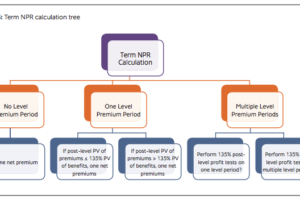By Mark Shemtob
Fans of the 1960s rock band Jay and the Americans might initially think that this article is about Mexico and a love story gone bad.[1] However, they would be mistaken. It is about Canada and an innovative approach to solving the retirement income challenge. Like the U.S., Canada has experienced a rapid decline in the number of traditional defined benefit plans, in turn creating a need to develop new approaches to tackling the lifetime income challenge. Purpose Investments[2] has developed such an alternative investment product, as described below.
What is this new product?
The Longevity Pension Fund (fund) is a mutual fund that includes several cohorts (as described in No. 3 below) registered with the Ontario Securities Commission and other regulatory bodies within Canadian provinces. It first became available for purchase in mid-2021. It is designed to pay income for life to those 65 years old and above through monthly distributions, and while there are no guarantees on the distribution levels, the Fund is designed so that distributions increase over time.
How does one buy shares in the Fund?
Shares can be purchased through an adviser or a self-directed brokerage account. The minimum purchase is $5,000. Shares are purchased directly from the fund manager, Purpose Investments. The purchase price is based upon the then current net asset value (NAV) of the fund. NAV is determined daily based upon the total underlying fund investments at market value.
What are the cohorts?
Cohorts are sold based on year of birth: (Cohort 1) 1945–47, (Cohort 2) 1948–1950, (Cohort 3) 1951–1953, (Cohort 4) 1954–1956, and (Cohort 5) 1957.[3] Different cohorts receive different income distribution rates as described below. There is one additional cohort for individuals still in the accumulation phase.
How does the Fund operate?
It pays a monthly distribution to the fund holders. The distribution rates paid out differ based upon the cohort and whether there is an annual commission being paid to an adviser. At the outset of the launching of the Fund, the initial payouts range from 6.15% for Cohort (4) to 7.40% for Cohort (1). The series that includes commissions are 50 basis points lower. The payouts do not differ by gender and are net of all fund expenses.
How do distribution rates change?
They change annually based upon actual prior investment, mortality, and redemption experience (described lower) in addition to changes in these assumptions going forward.[4] The distribution rates might increase or decrease. Ultimately distribution rates will be determined to maintain 100% funding level, though in early years of the fund increases might be limited to create a surplus.

How is the fund invested?
There is an Investment Policy Statement that the fund manager (Purpose Investments) follows that provides some flexibility. Initially the asset allocation was as follows:
Equities—43%
Fixed Income—36%
Alternatives—14%
Cash—7%
What happens when a fund holder dies?
Upon death, the fund holder’s beneficiary is entitled to a single payment of the lesser of the unpaid capital[5] or NAV. It is anticipated that the NAV will not apply unless the fund experiences significant early investment losses. The purpose of incorporating the NAV level is to prevent arbitrage opportunities by fund holders.
What is the payout amount should one wish to redeem their investment?
It is determined the same as if the fund holder died, though a total redemption is not required.
How were the initial distribution rates determined?
The initial rates were determined to be more conservative than expected based on best estimates. This was done to minimize the risk that the target distribution rates would decrease. The expectation is that distribution rates will increase with time. At the time distribution rates were initially set, an expected return of 4.55% (net of investment expenses) with a standard deviation of approximately 8.50% were assumed. The CPM14 Public Sector mortality tables, with a mortality improvement scale, were used.[6] Using stochastic modeling purposes for Cohort 4 (65- to 67-year-old group), a steady rate at an income level of 6.7% could have been achieved with a 50% likelihood of success. By lowering the distribution rate to 6.15%, the likelihood increased to 89% over a 25-year period and 83% over a 35-year period.[7]
How does the fund compare with a traditional insured fixed income life annuity?
A gender-blended cash refund annuity pays out for a retiree born in 1955 an annual amount equal to 5.46% of the premium.[8] The fund distribution rate (6.15%) for Cohort 4 is approximately 13% greater than this annuity. In addition, the fund offers liquidity at any time, while the annuity does not. The annuity payment amount is guaranteed by the insurer. The fund payout amount could decrease or increase.
How successful has the fund been to date?
Inasmuch as this is a new product just introduced in 2021, it is far too early to determine whether it will be widely adopted and whether it will be able to maintain distribution rates at or above the initial levels.
Is there anything comparable to the fund for sale in the U.S.?
Within the retail space, to date there is not. The Stone Ridge Longevity Risk Premium Fixed Income Trust[9] does have some innovative features based upon reducing longevity risk; however, it has not yet been brought to market. Within the institutional space, TIAA-CREF[10] (which has been around since 1952) provides plan members variable lifetime income. Non-ERISA church plans can offer variable lifetime income[11] and ERISA variable benefit plans[12] provide variable distributions based on actual investment performance.

This fund approach by our neighbors to the north offers a glimpse into some innovative thinking as to how individuals can achieve lifetime income. This is of value to those who don’t have access to institutional solutions. However, adding new programs further complicates the challenge that individuals have in designing their own retirement income strategy. A retirement saver can choose to use a self-regulated or structured drawdown approach and/or some other product like the fund, a fixed income insured annuity, or a variable annuity with a guaranteed benefit. How popular the fund will turn out to be—and how well it performs—will not be known for many years. It will be interesting to monitor.
MARK SHEMTOB can be reached at markeaasa@yahoo.com.
Disclaimer: The author has no affiliation with Purpose Investments, nor any positions in any funds mentioned in this article.
References
[1] https://www.youtube.com/watch?v=9l6WMNsKNVg. [2] https://www.purposeinvest.com. [3] New in 2022. [4] Determined by Purpose Investments but reviewed by third parties. [5] Unpaid capital is the original amount invested less accumulated amounts paid out. [6] For reference, the life expectancy for a male age 65 at the time the rates were set was roughly 23.2 years. [7] This modeling was based on fixed payouts though the fund pays variable amounts. [8] Based on Immediate Annuities website quote average of male and female rates as of Jan. 6, 2022. [9] https://www.sec.gov/Archives/edgar/data/1780133/000119312520072241/d893608d497.html [10] https://www.tiaa.org/public/pdf/cref_rules_of_the_fund.pdf [11] An example of a church DC variable income plan can be found here: https://media.porticocloud.net/pdf/100/100-01-ElcaRetirementPlanSummary-2020.pdf/ [12] https://www.plansponsor.com/variable-benefit-plans-solution-types-plan-




